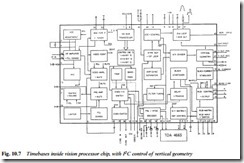LINE DRIVER
Interposed between the (in-chip) line oscillator and the output section is a matching circuit. Where the output device consists of an ordinary npn transistor (as opposed to a Darlington type) this driver
section takes the form of a transistor pulse amplifier with a step- down transformer as collector load. The functions of the line driver are twofold: it isolates the line generator stage from the switching impedance of the output transistor; and provides power amplification to drive the required considerable base current into the output transistor. Fig. 10.8 shows at left a typical line driver and output stage for a colour TV set or monitor. The line driver squarewave is applied to the base of Q402, which it switches fully on and off. The network C404 and R401 damps the primary winding of transformer T401; its secondary winding drives current in and out of the base of Q401, the line output transistor, here directly but in some designs via a network (which may involve R, C, L and D elements) to shape, damp and control current in the b−e junction of the output device.
